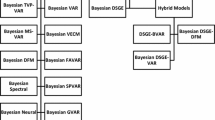Abstract
This paper considers modelling the annual logarithmed per capita gross national product of the United States in 1889–1987. Some authors have suggested that the parameters of the process generating the data have changed over time but formal parameter constancy tests do not support this argument. The series turns out to be nonlinear and can be adequately characterized by an exponential smooth transition autoregressive model. For comparison, a detrended series is also considered, found nonlinear and modelled using a logistic smooth transition autoregressive model. The behaviour of the estimated models is discussed, and it is seen that nonlinearity is needed to describe the response of the process to exceptionally large exogenous shocks. The properties of the models are further investigated by forecasting several years ahead, and the forecasts are compared with those from other linear and nonlinear models.
Similar content being viewed by others
References
Bates DM, Watts DG (1988) Nonlinear regression analysis & its applications. New York Wiley
Cecchetti SG, Lam P, Mark NC (1990) Mean reversion in equilibrium asset prices. American Economic Review 80:398–418
Christiano LJ, Eichenbaum M (1990) Unit roots in real GNP: Do we know and do we care? Carnegie-Rochester Conference Series on Public Policy 32:7–61
DeLong JB, Summers LH (1988) On the existence and interpretation of a “unit root” in US GNP. National Bureau of Economic Research, Working Paper 2716
Durlauf SN (1989) Output persistence, economic structure, and the choice of stabilization policy. Brookings Papers on Economic Activity 2/1989:69–116
Eitrheim Ø, Teräsvirta T (1995) Testing the adequacy of smooth transition autoregressive models. Journal of Econometrics, Forthcoming
Garcia R (1995) Asymptotic null distribution of the likelihood ratio test in Markov switching models. CIRANO, Département de sciences économiques and CRDE, Université de Montréal, Working paper 95s-7
Gordon RA (1961) Business fluctuations, 2nd edition. New York Harper & Brothers
Granger CWJ, Teräsvirta T (1993) Modelling nonlinear economic relationships. Oxford University Press
Hamilton JD (1989) A new approach to the analysis of nonstationary time series and the business cycle. Econometrica 57:357–384
Hansen BE (1992a) Testing for parameter instability in linear models. Journal of Policy Modeling 14:517–533
Hansen BE (1992b) The likelihood ratio test under non-standard conditions: Testing the Markov trend model of GNP. Journal of Applied Econometrics 7:S61–S82
Harvey AC (1985) Trends and cycles in macroeconomic time series. Journal of Business & Economic Statistics 3:216–227
Koop G, Pesaran MH, Potter SM (1995) Impulse response analysis in nonlinear multivariate models. Journal of Econometrics, Forthcoming
Lin C-F, Teräsvirta T (1994) Testing the constancy of regression parameters against continuous structural change. Journal of Econometrics 62:211–228
Lindgren G (1978) Markov regime models for mixed distributions and switching regressions. Scandinavian Journal of Statistics 5:81–91
Nelson CR, Plosser CI (1982) Trends and random walks in macroeconomic time series. Journal of Monetary Economics 10:139–162
Nyblom J (1989) Testing for the constancy of parameters over time. Journal of the American Statistical Association 84:223–230
Ozaki T (1985) Non-linear time series models and dynamical systems. In: Hannan EJ, Krishnaiah PR, Rao MM (eds) Handbook of Statistics Vol 5. Amsterdam Elsevier 25–83
Potter SM (1995) A nonlinear approach to US GNP. Journal of Applied Econometrics 10: 109–125
Romer CD (1989) The prewar business cycle reconsidered: New estimates of gross national product, 1869–1908. Journal of Political Economy 97:1–37
Seber GAF, Wild CJ (1989) Nonlinear regression. New York Wiley
Stock JH (1990) Unit roots in real GNP: Do we know and do we care? A comment. Carnegie-Rochester Conference Seeries on Public Policy 32:63–82
Teräsvirta T (1994) Specification, estimation, and evaluation of smooth transition autoregressive models. Journal of the American Statistical Association 89:208–218
Teräsvirta T, Anderson HM (1992) Characterizing nonlinearities in business cycles using smooth transition autoregressive models. Journal of Applied Econometrics 7:S119–S136
Tiao GC, Tsay RS (1994) Some advances in nonlinear and adaptive modelling in time-series. Journal of Forecasting 13:109–131
Tong H (1990) Non-linear time series. A dynamical system approach. Oxford University Press
Tyssedal JS, Tjøstheim (1988) An autoregressive model with suddenly changing parameters and an application to stock market prices. Applied Statistics 37:353–369
Author information
Authors and Affiliations
Rights and permissions
About this article
Cite this article
Teräsvirta, T. Modelling nonlinearity in U.S. Gross national product 1889–1987. Empirical Economics 20, 577–597 (1995). https://doi.org/10.1007/BF01206058
Received:
Revised:
Issue Date:
DOI: https://doi.org/10.1007/BF01206058
Key Words
- Linearity testing
- nonlinear time series
- smooth transition autoregressive model
- structural change
- univariate time series




